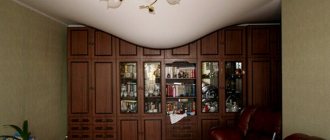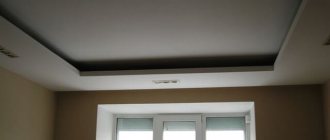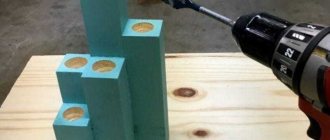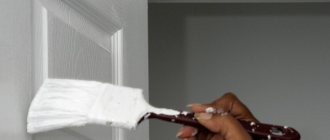Reasons for dismantling a stretch ceiling
If the suspended ceiling is accidentally damaged, it will have to be dismantled.
A suspended ceiling is a material that is fixed to the walls under some pressure - in a tense state. In this case, the canvas forms a perfectly flat surface. However, this tension makes him vulnerable. The slightest damage immediately turns into a huge hole.
In some cases, you can stop the discrepancy of the material and apply a patch. However, in some cases, dismantling the tension structure is the only possible solution.
- The tear or damage is far from the wall. With a short distance, the material can be pulled so that the separated fabric is outside the baguette. However, it is impossible to get rid of the gap in the center in this way.
- When installing lamps, it is necessary to make a hole in the canvas and secure it with a special ring or plate. If the hole is too large and the discrepancy cannot be stopped, you will have to remove the film.
- The ceiling is not afraid of leakage: the film can withstand up to several tons of water. But in order to remove accumulated water, you often have to cut the film or partially remove it.
- It is necessary to change the design of the room.
We dismantle the suspended ceiling without reinstallation
In this case, the procedure is simple, and you only need a screwdriver (if you don’t have a screwdriver), an upholstery knife and a stepladder. Make a hole near the wall. Cut the canvas along the perimeter along the frame at a distance of 3-5 cm. Then unscrew the screws and remove the profile. This method is used to dismantle a glazing bead stretch ceiling or in cases where re-installation is not planned. However, the canvas may still be useful, although its usable area will decrease.
How to remove a suspended ceiling yourself?
For cases of quick and successful removal of a stretch ceiling, it is important to prepare all the necessary tools. If the ceiling is made of PVC film, then the use of a gun will be mandatory
In addition, the main tools for such work will be: a spatula, preferably small, pliers that do not have serrations, and a knife. If the work is carried out with seamless polyester ceilings, then the gun will not be needed.
It is important to properly prepare the tools themselves so as not to damage the coating. The edges should be smooth, for which they are treated with fine-grain sandpaper
You can also use reinforced tape, which is used to wrap the uneven edges of the instrument to avoid damage to the ceiling covering. In the process of removing ceiling film, it is important to have an assistant, especially when the work involves using a gun.
In order to dismantle the PVC ceiling, you must first remove the decorative rubber inserts. Only after this can you start heating the canvas with a gas gun
In the place where the coating will be removed, it is important to heat with maximum intensity
With a wedge type of fastening, dismantling the canvas will be quite simple. After removing the decorative element, the wedges weaken and you need to slightly widen the edge of the groove with a spatula, then the wedge along with the canvas will easily come out of it. The work is carried out starting from the corner and moving further.
If you use a cam type of fastening, then you need to use a plastic shovel to mount the blades, which is inserted into the self-clamping mechanism. After this action, it will be enough to simply press on the cam and remove the ceiling covering from it.
With the harpoon fastening option, the work is carried out using pliers and a flat-head screwdriver. To remove the canvas, you need to make sure that the screwdriver picks up the edge of the harpoon edge, after which you can slowly begin to pull it towards you.
If you need to dismantle fabric panels, then it is important to take into account both the material and the type of fastening. If this is a clip system, then partial dismantling will simply be impossible
If you use the wedge method, then you can only disassemble the ceiling from the middle, otherwise you won’t succeed. Using a spatula, the profile is removed, the wedge is hooked and carefully removed along with the ceiling covering.
If your stretch ceiling has minor damage, there is a crack or a hole on it, then these problems can be easily fixed with your own hands. In order to eliminate the cause of the violation of the integrity of the coating, it is necessary to remove only the part where the repair will be carried out.
The instructions here are quite simple, after freeing the covering from the frame, you need to glue it with liquid wallpaper or a piece of the same canvas as yours, cover it with paint and put it back in place again
It is important to use transparent glue so that it does not leave marks on the surface of the ceiling. The paint is matched exactly to the tone of the ceiling covering to hide all traces of gluing
If it is important for you to dismantle your ceiling, preserve it and then install it in the same place, then all work must be done correctly, in compliance with technology, without haste. It is best to work with a partner who will always help and back up, because you will have to act at heights, which is not very convenient and not at all safe
Types of suspended ceilings and methods of dismantling
Events in our lives sometimes develop in such a way that it is necessary to immediately remove the canvas. These situations cannot be predicted. If such a need arises, then you need to take action as quickly as possible. Many resort to calling craftsmen from the company that made suspended ceilings. Naturally, this service is provided for a fee. There is nothing difficult in dismantling a stretch ceiling with your own hands; the main thing is to follow the recommendations and be extremely careful.
In order to dismantle the stretch ceiling, you should resort to the help of specialists, but you can also take on such work yourself
In addition to the fact that there is a PVC film or fabric base, there are some other nuances that need to be taken into account. Not all types of suspended ceilings can be removed and reinstalled. You need to know this when dismantling, so as not to be upset later. If you completely replace it with a new one due to a boring design or color, you don’t have to think about it, since they will install a completely different canvas.
When dismantling a suspended ceiling in an apartment, familiarize yourself with the type and type of structure installed (this data is indicated in the contract from the company). This knowledge will allow you to avoid mistakes and perform the removal yourself without the help of specialists.
Stretch ceilings are divided into types:
- Made from PVC film;
- On a fabric basis.
Installation of a stretch ceiling made of polyvinyl chloride film occurs due to exposure to high temperatures. Using a heat gun, the room is heated to 700 degrees. When installing a fabric-based ceiling, there is no need for heating. This is a significant advantage of this type of canvas.
As for dismantling, they are characterized by the following technologies:
- Removing PVC film from the structure begins from an angle (arbitrary);
- The fabric base is dismantled from the center.
Of course, a mention in a nutshell does not give a complete picture of the technology for removing a stretch ceiling with your own hands. Success directly depends on the accuracy of actions and slowness in the process. Read on for more information on how to dismantle both types. But first, we should mention the necessary tools for carrying out independent work on removing a stretch ceiling. It also differs, depending on the type of canvas.
How to repair a suspended ceiling in case of sagging
The sagging of a stretch ceiling spoils its aesthetics no less than the appearance of defects. It can occur for several reasons:
- The structure was installed poorly. The canvas is not tensioned enough and sagged under its own weight.
- Damage to the base ceiling covering. Pieces of putty or other finishing material fell onto the tension fabric.
- Ventilation is not organized properly. Air currents cause the ceiling film to swell.
All of the above situations require ceiling repairs. You can do it yourself only under certain circumstances.
It is not difficult to eliminate the consequences of unprofessional installation yourself, provided that the type of fastening allows you to partially or completely (depending on the specific case) remove the coating. It warms up and hardens again.
You can eliminate the sagging of the canvas by removing it, warming it up and installing it again.
When particles of the base ceiling collapse on the canvas, complete dismantling is most often necessary. The canvas is removed, cleared of debris and returned to its place.
Sagging due to ventilation installation errors requires ensuring the correct direction of air flow. Here it is worth taking advice from professionals or entrusting the work to specialists. Dismantling may be required either complete or partial (depending on the location of the ventilation equipment).
Repairing a suspended ceiling after a flood
What to do if the suspended ceiling is flooded? First of all, don't panic. You need to do the following:
- turn off electricity to the entire house;
- Call the appropriate service if there is a warranty on the design.
What not to do:
- Be afraid that the canvas will tear. PVC film for ceiling coverings can withstand a weight of 100 m3 per 1 m².
- Puncture the bubble formed in the center. Firstly, water will flood the room, damaging furniture and floor coverings; secondly, the canvas will receive damage that will need to be repaired.
After flooding, you cannot pierce the bubble formed in the center
Next should be the repair of the suspended ceiling after the flood. If this is done by a team of service specialists, most likely, no serious action will be needed at all: they will pump out the water and the canvas will be restored.
When fixing the problem yourself, first of all you need to carefully drain the water. To do this, you will need to partially dismantle the ceiling so that the liquid can drain and the canvas remains unharmed. It is worth using all kinds of devices in the form of improvised gutters and channels.
If, after removing the water, the canvas has not restored its original appearance, you can use a construction or household hair dryer. It will tighten as it warms up.
To drain the water you will need to partially dismantle the canvas.
Repair of fabric suspended ceilings: the most acceptable methods
Fabric stretch ceilings significantly complement the interior, making the rooms cozy and comfortable. As for performance qualities, they have significant differences from PVC film sheets. And first of all, this is the method of fastening. For fabric structures, glazing bead is used. To repair a hole in a fabric stretch ceiling, the patch will have to be applied to the front part.
Many specialists do not undertake dismantling such a ceiling at all, since it is very difficult to remove the glazing beads without damaging the canvas. You have to work only on the outside. To do this, you need to take the pieces of fabric remaining after installation, cut out a fragment of the pattern corresponding to the damaged one, apply glue and apply it to the surface. Under no circumstances should you apply intense pressure or rub.
If there are no residues, you can use a plain fabric of a similar texture, on which, after gluing and drying, you need to make the necessary pattern. It is worth noting that even with a high level of artistic professionalism, it will not be possible to accurately convey the shade of color. Therefore, it is very difficult to achieve a perfect result.
Before you glue the suspended ceiling with your own hands, as an option, you can sketch a pattern or ornament on a piece of fabric and cover the damaged area of the canvas.
Repairing fabric suspended ceilings is a very complex process, many specialists do not even undertake to carry it out
If you still succeed in dismantling the ceiling, the patch should be applied to the connected parts of the cut from the wrong side. On a colored canvas, such repairs are almost invisible. It is better to seal holes on the front part.
DIY tools for removing suspended ceilings
In order to begin any work, you should carefully study the technology and prepare the necessary equipment. 99% of the success of removing a stretch ceiling with your own hands depends on accuracy and leisurely actions. The saying “if you rush, you make people laugh” is very suitable for this situation.
If you decide to dismantle the stretch ceiling yourself, then the main thing is to do everything slowly, carefully and with an assistant
As for the tools, their choice depends on the type of stretch ceiling, but in general you will need:
- Small plaster spatula;
- Long-nose pliers (pliers with long jaws);
- Stepladder (if it is missing, replace it with a table, stable chair, stool);
- Electrician's knife (fitter);
- Gloves;
- Screwdriver with curved end;
- Large construction clothespins (clamps).
In order to dismantle a suspended ceiling made of polyvinyl chloride film, you will additionally need a heat gun. Since the installation process occurs under the influence of high temperatures, removal must be carried out using the same technology.
Grind off the corners of the plaster spatula and wrap the entire sharp surface with reinforced tape. If this advice is ignored, there is a risk of damage to the canvas.
How to drain water and remove stretched ceiling
Water enters the interceiling space as a result of flooding by neighbors above or a burst of risers or lines installed in the ceiling. Before you remove suspended ceilings and put them back, you need to prepare. The full list of events looks like this:
- De-energize the room. This must be done when the first symptoms appear - sagging, condensation, drips, drops.
- Notify your neighbors and shut off the risers supplying water to the apartments. To do this, call a plumber. The valves are located in the basement of the building.
- Call the company that installed the suspended ceiling and find out if it provides service. No - act on your own.
- Remove all electrical appliances from the room so that they are not damaged by water: TV, computer, all household appliances that can be removed.
- Clear the room of furniture and interior items. Cover large cabinets and sofas with plastic wrap. Transfer flowers, aquarium.
- Prepare containers. Ask your neighbors for buckets, basins, baby baths, large pots. It will take a lot of them, and it is better to have a supply than to drown the people living below.
- Determine the place where the water will pour out. This could be a hole for a spotlight, a ventilation grill, a chandelier, or a mounting area near the wall.
- Place a setting table or stepladder. This must be done under the drainage area. Don't use chairs. They are unstable and can cause injury.
- Remove lighting fixtures. First make sure that the wiring in the room is de-energized. Water transmits current, and there is a danger of becoming a victim of shock.
- Using a screwdriver, release the groove by removing the decorative tape. Use a spatula to loosen the fastening, and use a hook to pull out a fragment of the harpoon. Disconnect the fastening area.
- Have an assistant hold the canvas firmly. Under the weight of the liquid, the canvas can be released, and then the entire room will be flooded with accumulated water.
- Take a flexible rubber hose and insert its end into the hole so that the end is under water. Place the other end in a bucket or basin.
- Change containers until all the liquid has been removed. When changing, pinch the hose. Then water won’t spill onto the floor, and everything will be done neatly.
- If you decide to drain through the technological hole, carefully lift the curved fragment of the ceiling, directing the water in the desired direction.
After all the water has been removed, place the harpoon in the landing slot. Preheat the film to achieve elasticity. Install the decorative trim. It makes sense to let the moisture dry out and then work on lighting. After connecting the lamps, apply voltage. If the film has stretched and sagged, eliminate the deflection using a heat gun or hair dryer.
How to remove a suspended ceiling with a harpoon mount
A harpoon is a plastic flexible strip, which in cross-section is a hook (or harpoon, which is where the name comes from). The plank has medium hardness and is produced by the meter.
Harpoon system for suspended ceilings
The polyvinyl chloride fabric is marked and cut out, exactly copying the shape of the ceiling. A harpoon is welded to the edge of the canvas, along its entire perimeter. This is done using HDTV equipment, which is available at enterprises that install suspended ceilings. Once the harpoon is welded around the perimeter, it is firmly butt welded. The harpoon is inserted with a spatula into the groove of the baguette (profile), where it is fixed on the inner protrusion of the profile using its hook.
If the film is edged with a harpoon, removing the suspended ceiling with your own hands will not be difficult. To make the vinyl ceiling more flexible and stretchable, it is evenly heated with a heat gun. The recommended heat flow temperature is 70 degrees Celsius. Re-upholstering the ceiling starts from the corner of the room. Some home craftsmen heat only the corner from which the harpoon begins to be removed, and use a hairdryer to heat the vinyl.
Harpoon fastening of suspended ceilings
When removing the PVC sheet, it is necessary to remove the harpoon from the ledge (shelf) inside the profile. If this can be done in one place, then the rest of the canvas is removed by simply pulling it with a harpoon. The operating procedure will be as follows:
- Heat the suspended ceiling evenly, starting from its central part to the corners.
- Take a bent spatula and a screwdriver.
- Find a place in the corner areas of the ceiling where there is a sufficiently large gap between the wall and the surface of the canvas. It is necessary to ensure that in the removal area there is no place where the harpoon is glued end-to-end. This place is not very strong; the film may rupture under physical impact.
- Using a screwdriver, press out the harpoon, insert a curved spatula into the crack and hook the harpoon.
- To release the harpoon, move the spatula to the right and left by 10-15 cm, thereby slightly pushing the harpoon away from the baguette.
- The same thing is done on the other, perpendicular wall. This way, the harpoon in the corner of the room will be hooked by 2 blades.
- The shoulder blades are parallel to the wall and pulled down with little effort. The canvas with the harpoon comes out of the profile.
- Then move the blades along the walls and carefully pull out the film. If the ceiling area is large, the canvas is hung on clamps (crocodiles) to avoid stretching and deformation.
If the ceiling area is small, the vinyl film can be removed without preheating; for large-sized canvases, preheating is required.
How to repair a cut on a film stretch ceiling?
If the cut occurred on a film ceiling, then first you need to estimate its size. If the latter exceed 2 cm, then it is better to seek help from specialists. It is quite possible that it would be more advisable to replace the coating rather than repair it.
Method number 1. If the cut on the PVC film of the stretch ceiling is small in size, you can repair it yourself, taking into account all the nuances of such an event. If the cut occurred quite close to the wall (at a distance of up to 15 cm), then it can be hidden in the groove of the baguette. To do this, you need to stock up on 10 cm of antenna cable and glue. First, the cable needs to be glued close to the cut so that it is parallel to the baguette. You need to wait until the glue hardens well, and then use a hairdryer to heat the film.
Heat the cut area with a hair dryer
Directing warm air to the cut area, you need to smoothly pull the cable towards the wall, and then tuck it into the groove of the baguette, using a flat, blunt tool. If folds have formed during the work, you can get rid of them in the same way: glue the cable along them, heat the canvas, pull it to the wall and tuck it into the groove.
Prices for glossy stretch ceilings
glossy stretch ceiling
Repairing a cut near a wall
Method number 2. In a situation where the cut is far from the wall, there is only one way out - gluing a patch. It needs to be cut out from the remnants of the film, lubricated with transparent sealant or glue. Next, you need to remove the tape from the cut area and apply a patch there. Excess glue must be removed and the patch fixed for a while for better adhesion.
Decorative patch on a stretch ceiling
A small patch on a PVC stretch ceiling can be made decorative by cutting it in the shape of a flower, month, star, etc. A patch cut to match the color of the wallpaper will look especially impressive. For a more harmonious decor, you can cut out several shapes and arrange them beautifully.
- It is better not to repair holes in the canvas that have formed in its central part yourself, so as not to aggravate the situation.
- One of the options that can correct the situation is to install an additional lamp or ventilation grille at the site of the damage. To save the ceiling in this way, you first need to protect the coating from spreading at the cut site by installing a protective plastic ring. After this, you can install a light fixture or ventilation grille.
- If the cut occurs in the immediate vicinity of the chandelier, then it can be successfully disguised with the help of a decorative element. For example, use a piece of mirror or a polyurethane plate for this. As a result, the place of damage will be hidden, and the room will be decorated in a new way.
There are some requirements for the glue that is used to seal cuts in a suspended film ceiling. Firstly, it must be transparent - otherwise, unaesthetic white spots will remain on the ceiling. Secondly, the glue must harden quickly without destroying the polyvinyl chloride fabric during the drying process. Experts in the restoration of suspended ceilings advise using Cosmofen glue, which quickly and efficiently connects parts of the canvas without leaving marks. You can buy this product at regular hardware stores and building supplies departments. If “Cosmofen” is not found on sale, then you can ask the seller to provide a special glue for repairing suspended ceilings.
Prices for Cosmofen glue
glue Cosmofen
Glue "Cosmofen"
There are situations when suspended ceiling structures cannot be sealed and even professionals with extensive experience will not undertake this.
Installation of ceiling covering
If you want to remove your suspended ceiling for some reason, but then install it again, it is important to know some of the nuances of this process. So, if you have a bead fastening system, then it will be impossible to re-tension it and you will have to do a complete reinstallation of the covering
If you have a harpoon fastening system, then you can dismantle the covering and then hang it back in the same place.
The tool needed for this is the same as for dismantling. It is also advisable to work in pairs, because it will be very difficult to do everything yourself.
When planning to remove a suspended ceiling and then install it back, it is important to pay maximum attention to the removal process. If you act carelessly, the canvas may simply tear and it will no longer be possible to put it back. If this is your first experience, then it is best to use the services of professionals who will quickly and efficiently help you both remove the canvas and return it to its place.
You can learn from specialists the necessary knowledge, techniques, and skills.
If this is your first experience, then it is best to use the services of professionals who will quickly and efficiently help you both remove the canvas and return it to its place. You can learn from specialists the necessary knowledge, techniques, and skills.
If the installation process is a familiar thing for you, then there are no problems. The whole scope of work is familiar to you, the main thing is to set the goal correctly, follow the sequence of actions and be careful.
You need to place profiles around the perimeter of the room, and then heat the room with a gun. Using special tongs, fix the PVC film in the corners, and heat the rest with a gun. When everything is ready, use a special spatula to push the remaining part of the film into the grooves of the baguette. Upon completion of the work, you need to install decorative skirting boards and admire the result.
Installing a fabric ceiling requires extreme concentration. Once you fix the material, its position cannot be changed in any way, so you need to act very clearly, accurately calculating your strength.
The next stage is the installation of lighting fixtures. There should not be too many of them, so as not to deform the tension of the canvas. The place for lighting fixtures is thought out in advance and clearly calculated: the hole made can no longer be sealed, removed or hidden. The distance from the fittings of the lighting element to the baguette should not be less than 25 mm.
Procedure
A thermal ring is glued to the place of the future lamp and only after that a hole is cut into which all the wires are pulled out. After connecting the wiring, a special decorative profile is installed and the position of the object is adjusted according to the height of the canvas. The spring elements are pressed, the lamp is slightly pressed into the hole, after which it finally takes its position.
Useful tips from professionals
In order to remove the canvas around the entire perimeter, as well as the corner of the stretch ceiling, as quickly and efficiently as possible, we advise you to follow the following, quite important tips:
- To ensure installation work is carried out accurately and safely, it is better if you are assisted by one or two assistants.
- To install a ceiling made of tension material, choose only high-quality materials.
- Try not to use tools with sharp edges.
From the above we can conclude that dismantling a stretch ceiling is not difficult. Such work can easily be done with your own hands if you follow the basic recommendations and follow the technology.
Reasons for dismantling
Let's figure out when radical methods (complete dismantling) are required, and in which cases you can do without it.
Small damage to the surface. PVC film is a material that can be easily damaged by using sharp objects, throwing things up, etc.
If the section of the coating that is located close to the edge is torn, then after partial dismantling, the torn fragment should be carefully removed. Next, the damaged area is carefully glued to the edge near the harpoon, and then inserted into the baguette
With a wedge fastening method, rather than a harpoon, it is much more difficult to disguise the damage. If the coating comes off along the baseboard, it cannot be restored. Large cuts in the canvas can be sewn up with nylon thread, but the ceiling will not look aesthetically pleasing.
Sagging and major damage. Sagging is the result of sudden temperature changes. It can also occur due to improper installation. If the canvas is sagging and the warranty period has not yet expired, you should contact the company that did the installation. Company employees are required to correct this deficiency at their own expense. Large tears, especially where pipes are located, are very difficult to seal. Often, in such situations, the canvas is completely replaced.
Accumulation of moisture. Flooding by neighbors from upper floors is a common situation in apartment buildings. The result is sagging of the canvas in those areas where liquid has accumulated. The water can be drained by removing the chandelier (if there is one) and get rid of the liquid through the small hole formed. Before you begin, you must turn off the electricity supply to the room. Also, you need to prepare dishes for draining. When there is no liquid left at all, the flooded area needs to be thoroughly dried. The best option is to completely remove the canvas and dry it. If for some reason this is not possible, you should turn on the fan heater and leave it until the remaining moisture has completely evaporated.
Fungus. If the fungus has “attacked” the suspended ceiling, dismantling will be required. Also, it is necessary to treat with an antiseptic so that mold does not appear on the new coating.
Small damage to the surface Sagging stretch ceiling Moisture accumulation Fungus has appeared inside the ceiling space
Make a ventilation grill
If the ceiling covering is damaged, but the break is not large and is not located close to the wall, then you can try to hide it using a ventilation grill. The option is suitable for PVC ceilings, but not for the fabric version.
To hide a cut in a suspended ceiling from prying eyes, you must:
- Glue a plastic ring onto the hole. Purchased in a store or cut from PVC material yourself. The hole should be inside the ring.
- When the ring is firmly glued, you need to enlarge the hole without crossing the boundaries of the ring.
- Install the ventilation grille.
- The defect will be hidden and additional ventilation will appear.
It is important to use special glue for stretch ceilings, since the composition of regular glue may not be suitable and the gluing will be fragile. For this method of camouflage, a dummy fire system is suitable; it masks the problem well and looks aesthetically pleasing.
For this method of disguise, a dummy fire system is suitable; it masks the problem well and looks aesthetically pleasing.
Dismantling a stretch ceiling
Dismantling a stretch ceiling is the same process as installing it, only all steps are performed in reverse order. To start reupholstering the ceiling or replacing the old canvas with a new one, you may need certain tools.
Table. Tools needed to dismantle the ceiling.
| Tool | Use and Description |
| Ladder | Necessary to get directly to the canvas itself. Do not pile tables and chairs on top of each other to reach the ceiling. Besides, it's not safe. |
| Heat gun | Necessary for heating the room and the canvas itself. Without it, it will not be possible to install or dismantle the ceiling accurately. |
| Putty knife | Definitely with sharpened edges. It is advisable to wrap the work surface with reinforced tape. |
| Screwdriver | Necessary for dismantling the ceiling covering in the case of a wedge fastening system. |
| Pliers | If the ends are slightly rounded, the pliers can be used to grip both the edge of the masking tape and the fastenings of the canvas itself. |
Next, proceed directly to removing the canvas.
Dismantling a straight tension structure
Step 1. Pull the masking tape out of the grooves along the wall
Remove it very carefully so as not to damage the ceiling covering (of course, if you do not plan to change it at all). Do not use sharp objects to remove inserts
Start pulling the tape out from where it joins (it's very visible at close range). The joints are usually located in the corners of the room. The edge of the edging can be picked up with pliers.
Removing Masking Tape
If a decorative plinth was used instead of masking tape, then it must be torn off from the surface. As a rule, glue, sealant or putty is used to attach skirting boards.
Step 2. Now warm up the room thoroughly with a heat gun. Also take care of heating the ceiling sheet. Remember that before heating a room, you should remove all interior items that cannot withstand high temperatures.
Heating with a heat gun
Step 3. Examine the entire ceiling structure and find out how the canvas was secured, since its further dismantling will depend on the type of fastening.
Methods of fastening a stretch ceiling
Step 4. Dismantle the canvas. If you have a harpoon fastening system, then start dismantling the ceiling from the corner of the room. Grab the harpoon with pliers and carefully pull it out. Always remove the canvas from the corners to the middle of the wall.
Scheme of harpoon fastening of a stretch ceiling
Removing the harpoon with pliers
If you have a glazing bead (wedge) fastening system, then bend the aluminum profile slightly with a spatula and release the glazing bead. Pull it out with a flathead screwdriver (be careful not to damage the material).
Bead fastening of stretch ceiling
If you have a cam fastening system, then bend the profile and release the wedge, and then the blade. Work from the corners of the room to its middle.
What you need to know about suspended ceilings before removal
You can dismantle it yourself. You just need to decide what exactly the procedure is for. Sometimes there is no need to remove the entire canvas; it is enough to remove only part.
@sdstroy777.ru
Reference. Before dismantling, you should find out what type of structure and fastening was used. The choice of coating removal technology depends on this.
If the cause of such work is a flood, then first get rid of the water. It is enough to remove any ceiling lamp and drain excess liquid through the resulting hole. Another way is to carefully bend the corner and pour it into a bucket.











